| Don't like ads? | No ads |
Rarely in the entire world of whiskey has one product come to exemplify the entire category as much as Joseph Magnus has with their “Cigar Blend” Bourbon. Do other examples of Cigar Blends exist? Of course. But they are all playing catch-up to Joseph Magnus. And if there is one reason why this is, it’s because of Nancy “The Nose” Fraley.
Cigar Blend
Nancy Fraley’s Passion Project that changed the landscape of finished bourbons
Nancy Fraley’s real world experience with spirits started when she began to work for a 10th generation Cognac distiller who came to California in the 1980’s. California was attracting more than just winemakers due to the surge of vineyards. Skilled distillers with backgrounds in grapes were also flocking to the area to see if they could create spirits with the same quality as those in France.
She recalls being fascinated with a type of brandy that her employer – Germain-Robin Distillery – began to make. It was called “Old Havana” and was a “Cigare Blend” style of brandy made in the French Cognac tradition. Her journey with blending and tasting that came afterwards honed her impressive set of skills. It wasn’t long before she was applying those talents by blending spirits from around the world.
Many years later, she was hit with an idea while smoking a pipe (a hobby she’s enjoyed on and off for 30 years she says) outside of her California home underneath the night sky and some nearby redwood trees. What if she took her knowledge of Cognac and Brandy and applied it to bourbon? Those two spirits are quite different from each other in terms of strength, but she recalled her experiences with Cigar Blends and how those were blended solely for their strong and robust qualities.
Her idea for making a Cigar Blend bourbon was to produce a spirit that echoed the quality, complexity and finesse of the Old World Cigar Blend Cognacs. Cigar Blends are typically robust enough to stand up to the powerful flavors and scents of a cigar. This is no easy task, but to those who love the finer things in life, such pairings are difficult to find. As luck would have it, one of the many producers that employed her services had just the right tools to make this dream into a reality: Joseph Magnus.
Creating the Category: How Joseph Magnus Cigar Blend came together
As of 2016, Nancy had been signed on with the Joseph Magnus team for about a year. She was also working for multiple distilleries with a wide range of products like rums, tequilas, brandies and bourbon. What set Joseph Magnus apart from the rest of the producers she was working with was the large inventory of well-aged bourbon from Indiana. She appreciated the richness and oak that it was known for. But she wanted to incorporate a style of brandy with the bourbon so it would more closely resemble the Cigare Blend Cognacs she was familiar with. Ultimately, she landed on Armagnac as the most capable spirit to stand up the heavy oak of bourbon.
At that point in time, Armagnac was a spirit that few Americans were familiar with – let alone an Armagnac-finished whiskey. This spicy spirit is a type of brandy made from grapes that differentiates itself from other brandies like Cognac based on the region in France it’s made in, the distillation/maturation process it goes through and the varietal of grape it uses.
One of the things that separates bourbon from most other spirits produced overseas is the size of the barrel. Bourbon uses a relatively small 53 gallon barrel (200 liters). Brandies, such as Armagnac, and fortified wines like Sherry and Port tend to use barrels that are between 300 and 500 liters in size. And since bourbon loses a lot of volume during the aging process (around 1/3 to 1/4 of the liquid typically remains after 10+ years of age), Nancy found that she had a lot of room to blend multiple barrels of bourbon prior to putting them into the Armagnac casks.
As time went on, Nancy developed what she called the “Coupe Mere” concept for making more consistent – but still unique – batches of Cigar Blend.
Breakdown of a typical “Coupe Mere” and Batch
A core concept of Nancy’s approach to making a Cigar Blend out of bourbon was the creation of a “Coupe Mere” or Mother Blend. The creation of a proper Coupe Mere was crucial because she wanted to create a batch of bourbon that was balanced just right. If the blend was too sweet, she could add more dry, tannic bourbon. If it was too dry-tasting, she would adjust it either by adding sweeter bourbon barrels or some stocks of Joseph Magnus Triple Cask which had been finished in relatively sweet Sherry and Cognac casks.
Starting around Batch 11, Nancy blended together Coupe Mere’s that were large enough to fill multiple barrels. By blending together 10-12 barrels, she could fill 4 Armagnac barrels. A few iterations later (starting with Batch 23), she bumped up the size of the Mother Blend to fill 6 Armagnac barrels at a time.
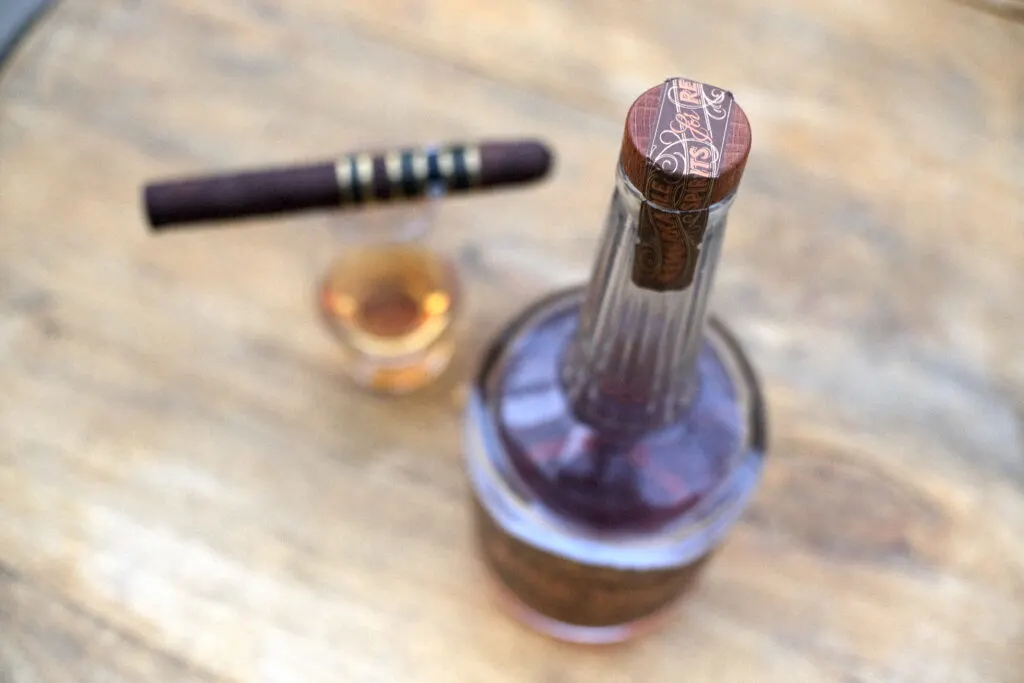
It was noticed that the batches differed from each other due to the profile of the Armagnac barrel. Within the same Coupe Mere of batches, some barrels were spicier than others. Some became sweeter and some shared characteristics more in line with wine than bourbon. The total amount of bottles that came from one batch also fluctuated based on maturation time, evaporation and other variables. Nancy has said that each “Batch” (the result of one barrel) can produce anywhere from 320 to 420 bottles.
The Finishing Process – Explained
The finishing process of Cigar Blend isn’t talked about that much. I think most people clock out after hearing about the blends and they assume the rest is automatic. The bourbon is only halfway there after the Coupe Mere gets added into the Armagnac barrels. Nancy stresses that the finishing process must be watched over more frequently than most people think. She personally checks the taste of each barrel every two to three weeks. How does she do this if her home is in California? She gets sampled overnighted directly to wherever she’s at. Then she tells the crew at the warehouse when to dump the barrels.
Nancy also claims that she does more frequent check-ins during the summer months since the change in weather typically allows for faster oak extraction. There are also other factors that come into play with how long a barrel will take to complete. Sometimes Cigar Blend batches are dumped into Armagnac barrels that have already been used. This requires longer finishing times to get the same level of extraction. Sometimes the barrels are larger (400 liter ones are sometimes sourced) which affects finishing times. All told, Nancy says that Cigar Blend takes anywhere from 4 to 12 months to finish.
The Early Years: Batch 1 through 10
Batch #1 – Nancy completed Batch #1 sometime around November, 2016. This inaugural batch is tied with Batch #3 and #14 for the lowest proofed Cigar Blends ever at 100.7 proof. Nancy said that she “christened” the first batch with a few drops of whiskey from the original bottle of Joseph Magnus from 1892. The other components of the blend were 9 year old MGP bourbon (60/36/4 mash bill), 18 year old MGP bourbon (75/21/4 mash bill) and a healthy dose of 10 year old Joseph Magnus Triple Cask Bourbon – probably somewhere 20-25% of the blend.
Batch #2 – Not much is known about this batch except that it was released almost 6 months after the first batch. This was the longest waiting period between batches being released, but is probably understandable since it was still a relatively new product. Nancy listed 3 batches as her favorites and #2 was one of them.
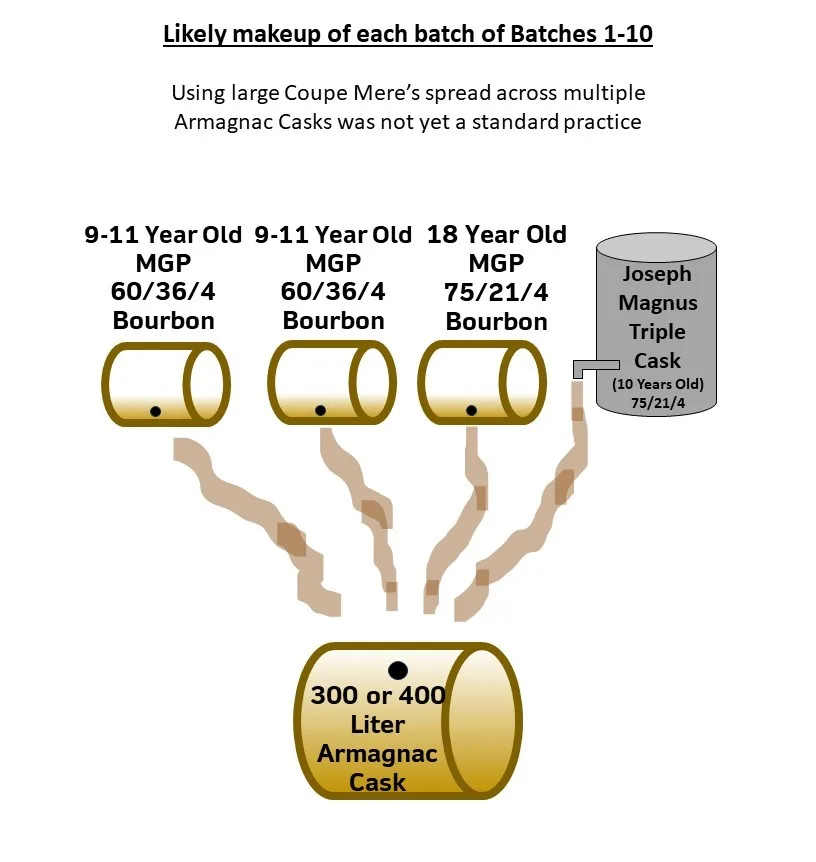
Batch #3 – This batch was sold to a private buyer which later turned out to be Prav Saraff and his bar/liquor store located in Washington D.C. Nancy admitted that the Coupe Mere was not properly adjusted to her specifications before it was dumped into the finishing barrel, so “it is probably the least representative of what Cigar Blend should actually taste like.”
Batch #4 – Nancy has hinted that this batch was a “knock out” and one of her personal favorites. At this point, the high-rye MGP bourbon has probably hit 10 years old and the older low-rye MGP bourbon has hit 19 years old.
Batch #5 – Not much is known about this batch other than every bottle that came from it was sent to Japan. I cannot find any pictures of it online.
Batch #6 – The third batch that Nancy lists as one of her personal favorites, it’s also one of the highest proofs yet coming in at almost 113 proof.

Batch #7, #8, #9 and #10 – Not much changes for these four batches. At some point, the high-rye MGP bourbon hit 11 years old and the amount of Joseph Magnus Triple Cask bourbon used in the Coupe Mere dipped to around 15%-20% of the total blend.

Batch 11-14
These particular batches get their own section because of two important reasons. The first is that they were the last “All-MGP” batches made for the next several years. The second is that it was the first time that a large Coupe Mere was created to fill multiple barrels at one time.

Nancy says that the MGP barrels used in this batch were all between 97 and 110 proof, which ultimately led to an average Coupe Mere proof of 103 before it was split up into the 4 Armagnac barrels. Interestingly, Nancy recorded that the proof of the 20 year old MGP 75/21/4 bourbon was around 106 proof. That’s pretty high for that age. The other MGP bourbon that was used was the high-rye variety and was 13 years old.
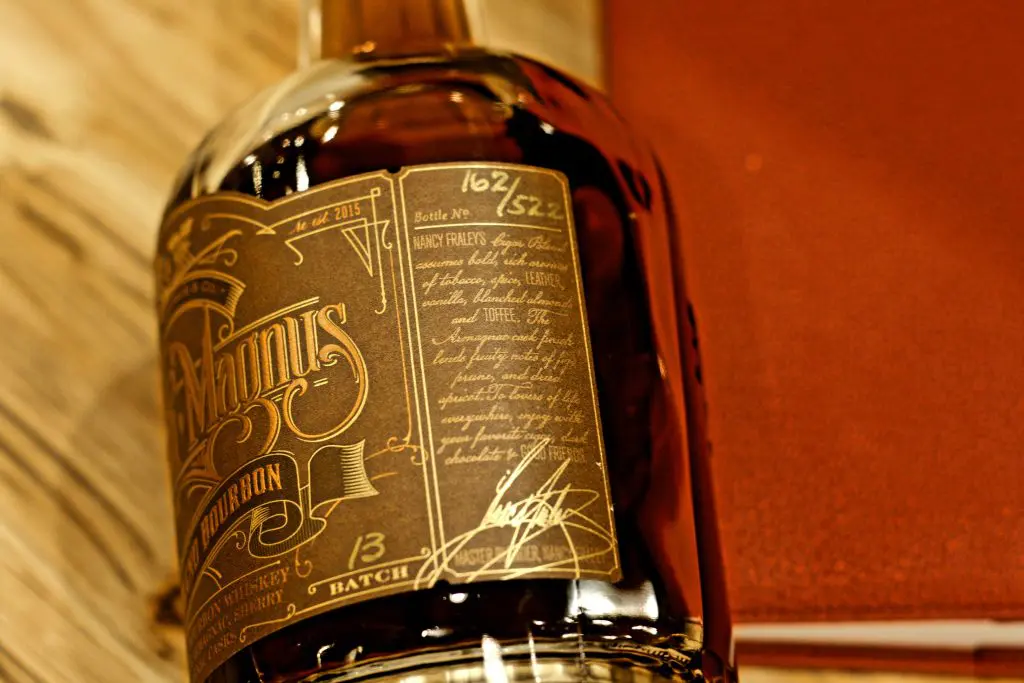
Nancy also mentioned she cut the amount of Joseph Magnus Triple Blend bourbon down to only about 1% of the total Coupe Mere. From that point forward, any Coupe Mere of Cigar Blend never used more than 3% of Joseph Magnus Triple Blend.
The Armagnac casks that were used for these batches were previously used from the first ten batches.
Batch 15 – 98 (The Barton Batches)
Batch 15-18
This is the first Coupe Mere to use barrels of Barton Bourbon in the blend (likely the 74/18/8 mash bill). What’s strange is that the average proof of the Mother Blend remained relatively low for this set of batches, averaging 106 proof. This low proof is one of the reasons why enthusiasts didn’t initially realize that the blend had changed. The state on the distillation wouldn’t change for a while either. More on that down below.

The labels would continue to show “Distilled in Indiana” on them for a few more sets of batches due to TTB regulations allowing producers to use up old labels first if they had any left over. Only after Nancy divulged the truth about the components of the blend did it begin to make sense. As an aside, the MGP barrels that she used must have been SUPER low in proof, like, I’m talking in the 90’s.
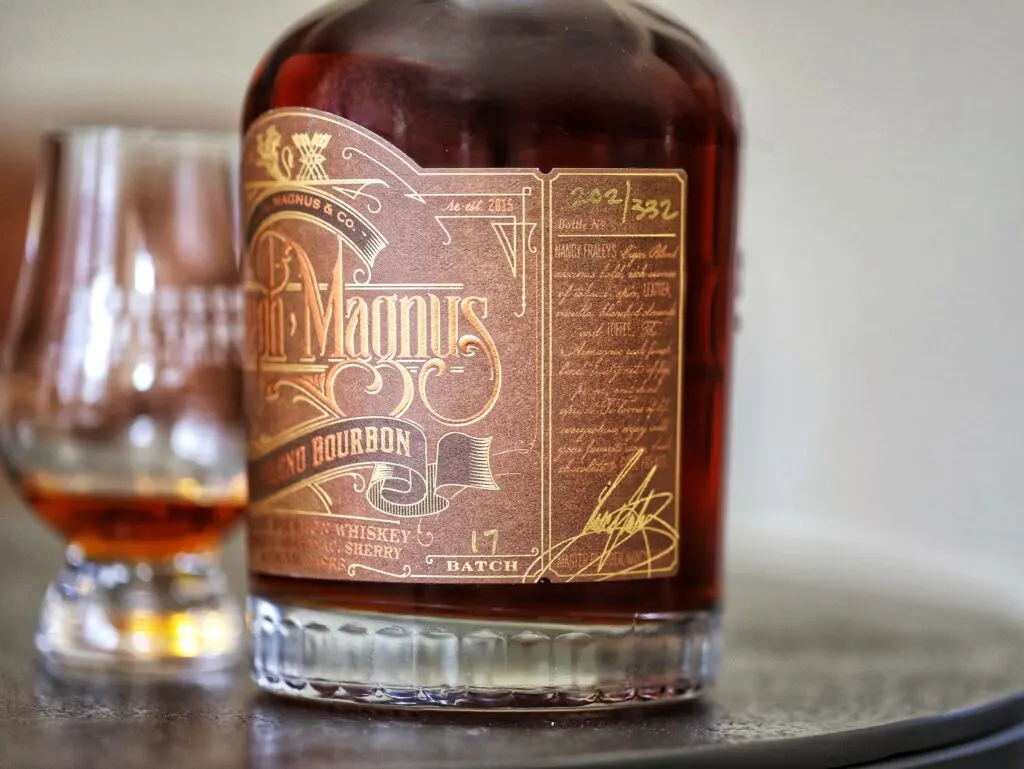
It is also said that this set of batches were finished in larger 400 liter Armagnac Casks compared to the 300 Liter ones used on the previous 14 batches. They were also rumored to be first-fill.
Link to Nancy Fraley’s Tasting Notes for Batch 15-18
Batch 19-22
This was the first set of batches where enthusiasts realized something was up with the bourbon components being used. Batches 19-22 all had a final proof between 124 and 124.3. This was about a 14.5% increase in proof over the previous set of batches.

Nancy Fraley later admitted that the Barton barrels used in this batch were between 12.5 and 14 years old and some were as high as 134 proof. On the other side, MGP barrels (likely the 20 year old ones) were as low as 95 proof. The Coupe Mere contained a majority of 14 year old Barton barrels.
Link to Nancy Fraley’s Tasting Notes for Batch 19-22
Batch 23-28
Another high-proofed set of batches (all above 120 proof), this Coupe Mere would see an increase from 4 Armagnac barrels to 6. A trend that continues into 2024.

There was a labeling error where Batch #23 and #27 did not have their proofs written on the label. Nancy clarified that Batch #23 was 62% ABV and #27 was 61% ABV. They each yielded 390 bottles which was on the smaller side.
Link to Nancy Fraley’s Tasting Notes for Batch 23-28
Batch 29-34
Nancy reveals that with the bump up in total barrels produced per Coupe Mere (to 6), that the number of barrels she has to blend together has increased to at least 16. She claims that each Armagnac cask takes on average 2.6 barrels of bourbon to fill.
The bourbon used in this batch is as young as 13.5 years old (Barton) and still contains 20 year old MGP bourbon (75/21/4). These batches took 5 months to finish in their Armagnac casks.
Link to Nancy Fraley’s Tasting Notes for Batch 29-34

Batch 35-40
Not much has changed with this batch of barrels as far as the makeup goes, but this is the first set of batches that would say “Distilled in Indiana and Kentucky” on the label.
Link to Nancy Fraley’s Tasting Notes for Batch 35-40
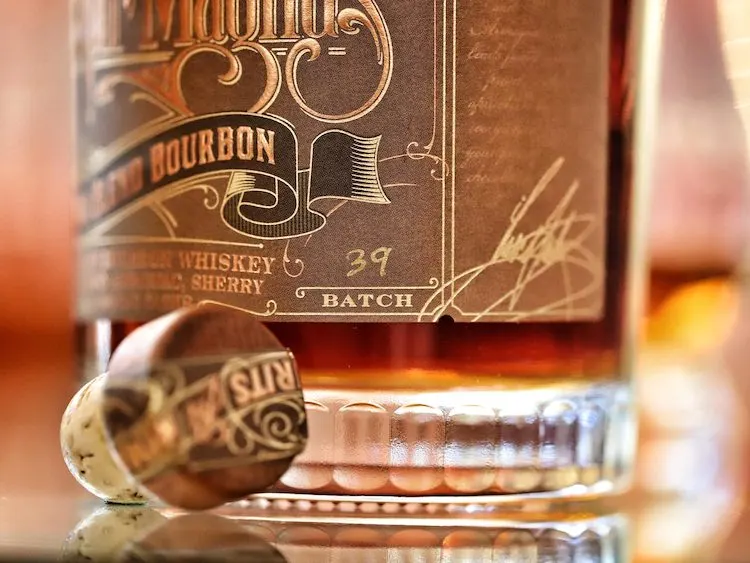
Batch 41
Perhaps as a nod to the fact that Joseph Magnus had made up their mind to move from Washington D.C. to Holland, Michigan, this would be the inaugural batch of “Michigan State-only” Cigar Blend. Batch 41 was only sold at liquor stores inside the state of Michigan.
Link to Nancy Fraley’s Tasting Notes for Batch 41
Batch 42-47
The news that Joseph Magnus was moving their operations was a shock to many. There was some speculation that the DeVoss family (who are large financial backers of the brand) was unhappy with their operations being in Washington D.C. so they moved the brand to their home state of Michigan.
All equipment and barrels were moved by truck to the Holland Distillery and as a result, Nancy decided on batch names that would commemorate the trip. She dubbed them “The Rock and Roll Series” because of the extra amount of liquid movement/sloshing inside of the barrels as they made their trip. For example, Batch #45 was given the name “Shake, Rattle & Roll.”
The Barton bourbon barrels used in this Coupe Mere are said to be a blend of 13.1 to 14 year old. 20 year old MGP was also used.
Link to Nancy Fraley’s Tasting Notes for Batch 42-47
Batch 48-52
This set of batches only contained 5 barrels of Armagnac instead of the new standard of 6. My theory is that the sixth barrel was used for Batch 41 (the Michigan-only batch). Additionally, the 6th barrel could have been held back for the 2nd “Michigan-only” Batch a few months later (Batch 59). The Joseph Magnus Website still indicates that this Coupe Mere was comprised of 16 barrels of bourbon in the blend.
Link to Nancy Fraley’s Tasting Notes for Batch 48-52
Batch 53-58
The standout of this set of batches was Batch 58 – also known as “Darth Vader” – because it was (and still is) the highest-proofed Joseph Magnus Cigar Blend Batch ever. It clocks in at 66.17% ABV or 132.34 Proof. For the next set of barrels, Nancy admitted that Barton barrels as high as 139 proof were being used – which is undoubtedly how this particular batch got so high.
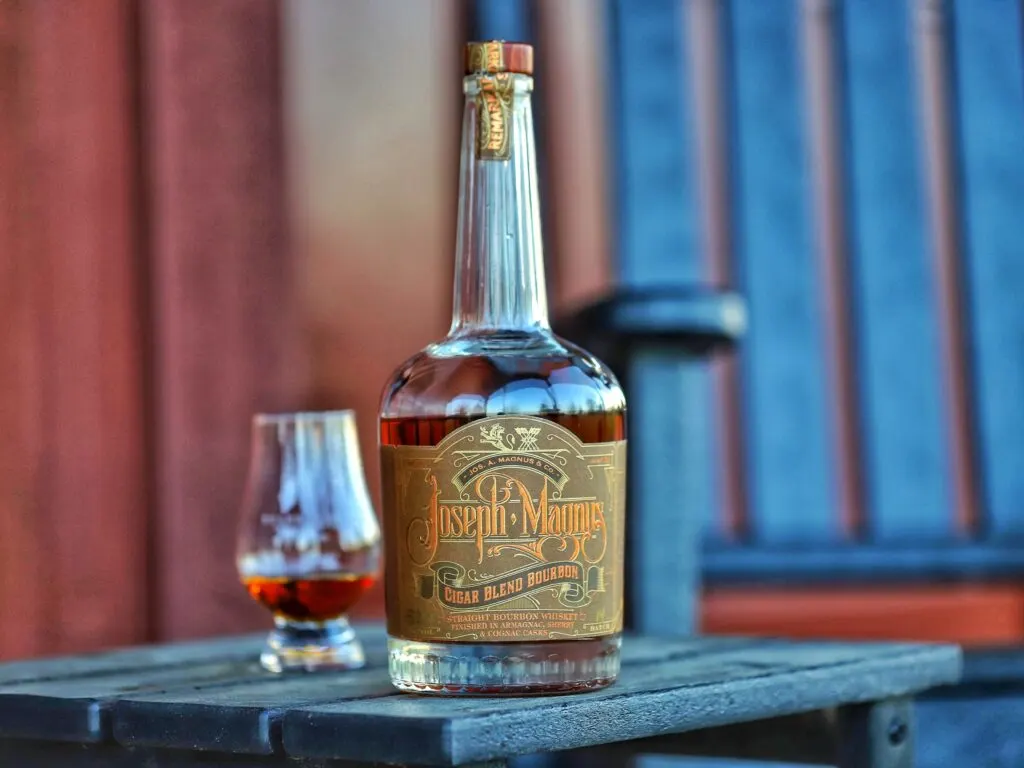
Link to Nancy Fraley’s Tasting Notes for Batch 53-58
Batch 59
The second batch of Michigan state-only Cigar Blend. There are no tasting notes that I could find from Nancy Fraley and no mention of it Joseph Magnus’ website. The proof of this batch was 117.84 Proof.
Batch 60-65
Nancy called out that the Coupe Mere used to make Batches 60-65 contained a large number of very high-proofed Barton barrels – between 132 and 139 proof. They were 14.5 years old at that time.
Link to Nancy Fraley’s Tasting Notes for Batch 60-65
Batch 66-71
No specific details or stories exist about this set of batches.
Link to Nancy Fraley’s Tasting Notes for Batch 66-71
Batch 72-77
The Barton bourbon barrels reach 14.8 years old. 20 Year Old MGP remains the same (and is likely tanked at this point in time). Nancy also points out that only a very small amount of Joseph Magnus Triple Cask is still being used in each Coupe Mere.
Link to Nancy Fraley’s Tasting Notes for Batch 72-77
Batch 78-83
No specific details or stories exist about this set of batches.
Link to Nancy Fraley’s Tasting Notes for Batch 78-83
Batch 84
Batch #84 is the third release of the Michigan-Only Cigar Blend. It was blended to celebrate the deep agricultural heritage and fruit-growing history of the state. It was composed of just three barrels that are then put into an Armagnac barrel for finishing.
Link to Nancy Fraley’s Tasting Notes for Batch 84
Batch 85-90
No specific details or stories exist about this set of batches.
Link to Nancy Fraley’s Tasting Notes for Batch 85-90

Batch 91
Batch 91 is the 4th release of the Michigan-Only Cigar Blends.
Link to Nancy Fraley’s Tasting Notes for Batch 91
Batch 92
Cigar Blend Batch #92, named “1892,” is a special edition of Cigar Blend that commemorates the founding of the original Jos. A. Magnus distillery in Cincinnati, Ohio in 1892. The “1892” batch is a unique blend of 4+ of our some of our finest IN and KY Bourbon barrels, plus a splash of the original Bourbon from 1892 that Joseph Magnus sourced 130+ years ago, which had been either matured or finished in ex-Sherry casks.
Link to Nancy Fraley’s Tasting Notes for Batch 92
Batch 93-98
No specific details or stories exist about this set of batches.
Link to Nancy Fraley’s Tasting Notes for Batch 93-98
Batch 99 to 111
Batch 99-104
Nancy had previously claimed that Batches 15 to 97 (but I think she meant 98) were heavily comprised of Barton barrels since they had a very short supply of aged MGP barrels. So I’m drawing the conclusion that this particular Coupe Mere saw a large uptick in the quantity of 36% MGP bourbon coming back into the blend. We can also assume it was aged around 9 years old.

That does not mean that the blends no longer contained Barton, but they were used less and less with the ultimate goal of removing them completely.
Link to Nancy Fraley’s Tasting Notes for Batch 99-104
Batch 105-111
Peculiarly, this is the first Coupe Mere to produce 7 Batches from it. No explanation was given as to why. Batch 111 also marks the beginning of the hiatus Nancy took from tasting notes due to health issues.
Link to Nancy Fraley’s Tasting Notes for Batch 105-111
Batch 112 to 182
Nancy still guided the creation of Coupe Meres and the finishing process during this time, but provided no accompanying tasting notes. She claimed that writing each set of batch’s notes took her up to 16 hours to complete and she did not have the time or energy to complete this process due to her ongoing health issues. She also has said that she will not retroactively go back and publish tasting notes.
The one thing she did offer insight on is how she believed batches “around 120” were underwhelming in her eyes.
Additionally, sometime in 2023, Nancy noted that Joseph Magnus was releasing 12 batches at a time (2 Coupe Meres) which was an increase from previous years.
Batch 183 to 206
Batch 183-188
No specific details or stories exist about this set of batches.
Link to Nancy Fraley’s Tasting Notes for Batch 183-188
Batch 189-194
Link to Nancy Fraley’s Tasting Notes for Batch 189-194
Batch 195-200
Nancy indicated that these batches are a blend of 9-year-old 36% ryed bourbon and 21% ryed bourbon from MGP bourbon. Additionally, some 16-year-old Barton bourbon was still used in the blend. Interestingly, she commented that 20-year-old MGP 36% ryed bourbon was used, which is a departure from her earlier statements that Joseph Magnus had a large amount of 20 year old 21% ryed bourbon that she used for blending. I believe this is just a typo.
Nancy claimed the 9 year-old components were aged in a cool and damp area of warehouses in Indiana, so the color wasn’t as deep as previous Cigar Blend expressions. Some side-by-side photos prove this to be the case.
Link to Nancy Fraley’s Tasting Notes for Batch 195-200
Batch 201-206
Same bourbon components as Batches 195-200. The Coupe Mere used in #201-206 are said to be a blend of 18 bourbon barrels, which went into six, 300-liter Armagnac casks. This would indicate the barrel amount went up by 2 barrels for this batch. I believe that the total amount of barrels used in each Coupe Mere probably varied somewhere between 16 to 18 barrels for some time.
Link to Nancy Fraley’s Tasting Notes for Batch 201-206
Batch 207 to ~249
At this point, no additional tasting notes or information exist about these batches. As of February, 2024, I am aware of batches into the 220’s. Nancy indicated these contained a blend of 9 year old 36% MGP Bourbon and 20 Year Old 21% MGP Bourbon. No word on if the Barton has been eliminated from the blend just yet.
Batch 280 and beyond
Nancy Fraley has recently stated (as of March, 2024) that Starting with Batch 280, that Joseph Magnus Cigar Blend is now back to using 10+ year old MGP “high rye” bourbon barrels as the youngest component in the blend. They are also from different stocks than the 9-year-old high rye bourbon stocks they were previously using. There still will be some 16+ year Barton in the blend as well as 20-year-old MGP bourbon, but she’s excited to announce that these new Coupe Mere’s are the closest to the original 14 batches that she’s ever made.

Other Fun Facts I Uncovered
Nancy still has access to some of those barrels of Barton Bourbon. She has shared pictures of samples that she takes home to experiment with. One particular photo showed a barrel that was 17 years old and 152.2 proof (76.1% ABV)! She calls that particular barrel the “Liver Bruiser.”
Joseph Magnus Triple Cask is always made from MGP’s 21% ryed bourbon recipe.
The use of 400 liter Armagnac barrels has not stopped. Nancy commented that a particular set of batches she was working on in 2023 were using them instead of the 300 liter ones.
When the pandemic hit, their supplier for Armagnac barrels slowed to a crawl. They had no choice but to reuse Armagnac casks 2 or 3 times. The situation was resolved – at the latest – in early 2023.

Nancy’s thoughts regarding other producers making a Cigar Blend: “My hope is that if there are more Cigar Blend Bourbons coming out in the future, that the producers/distillers/blenders of these whiskeys have some sort of understanding and appreciation of the long history of ‘cigare blend’ Cognacs and brandies. My fear- and I’ve already seen at least one example of this- is that the whole concept will be done in a gimmicky way, using components that are too youthful or faulty, using poor quality cooperage if they intend to do some sort of cask finishing, and not taking the time or having the skill to make their versions of a Cigar Blend live up to the quality, complexity, and finesse of their Old World Cigare Blend Cognac antecedents”
Nancy “The Brain” Fraley – She earned her Masters degree from Harvard University back in 1997 in World Religions, with a specialty in Tibetan Buddhism.
Nancy’s thoughts on Armagnacs – “…I 100% agree that Delord 25yr is one of the best Armagnacs out there, especially for its price point. I would also recommend you try out the Darroze line of Armagnacs. The Darroze 20 yr is excellent for the money, although I’d have to say that the Darroze Chateau de Gaube and Domaine de Rieston Vintage Bas Armagnac bottlings are among my all-time favorites.”
Nancy’s Resume
Have you been impressed with what Nancy has accomplished with Cigar Blend? Here’s a list for you to check out other products she’s had a hand in blending if you want to experience more!
– J. Magnus Cigar Blend Bourbon and all other J. Magnus whiskeys
– All of Wyoming Whiskey’s releases since Oct. 2014
– All J. Henry & Sons Bourbon bottlings
– All early Iron Root Republic releases
– Early Privateer rum bottlings (2011-2012)
– Smooth Ambler’s Contradiction, as well as some other SA products
– St. Augustine Bourbon
– Kamet whisky, a single malt from India that she worked on with master blender Surrinder Kumar
– South Hollow Spirits Twenty Boat Rum (out of Cape Cod)
– Rhum Civil, a spiced rhum from Haiti
– Seven-Three Irish Channel Whiskey
– Kimo Sabe mezcal
– Paqui tequila
– Copalli rum from Belize
– Sacred Stave American Single Malt whisky
– Early Whisky Del Bac Single Malt
– Yellow Rose Blended Whisky
– Sonoma Distilling Co.
There are other distilleries she’s worked with but can’t discuss because of NDA’s.
Featured Products
- Neat Traveler

- View Larger
- Description:The Aged & Ore Neat Traveler is a complete travel kit for spirits. We combined our widely praised Neat Glass with one of our 3oz Flight Bottles and housed them together in a custom EVA travel case. Perfect for a night away with your favorite pour. The tie
- Bottle Flight

- View Larger
- Description:The Aged & Ore Bottle Flight is a premium set of 4 custom silicone wrapped glass bottles designed to transport and share samples of your favorite spirits. The flight bottles come in a custom EVA travel case that fits perfectly in any small bag. An Aged &
- Travel Bundle
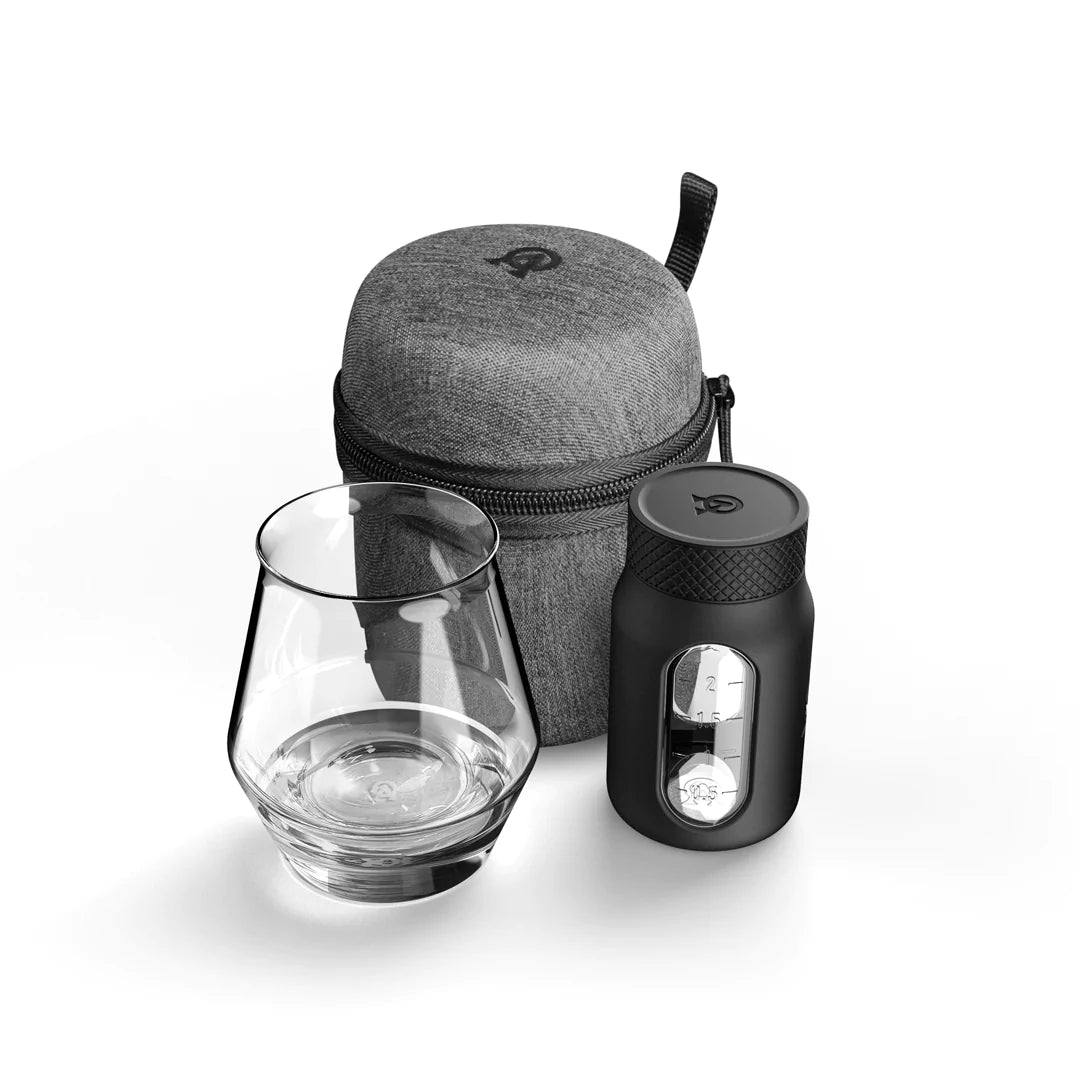
- View Larger
- Description:This Bundle combines two of our crowd favorite products, creating the ultimate travel bundle to bring along your favorite spirits and glassware. Bundle Includes: Neat Traveler (Gray) Bottle Flight (Gray) Note: This bundle is only available in gray and col
*Bourbon Culture is reader-supported. When you buy through links on our site, we may earn an affiliate commission.


Nancy Fraley
Wednesday 20th of March 2024
Hey Fellas, Master Blender Nancy Fraley here. Wow, I am in complete awe as to just how meticulous and painstaking your research was in making this complete guide to JMCB. This is absolutely brilliant, and the most accurate account of it that I've seen to date! I love the charts that show how each coupe mere is formulated too. It is very clear that you really understand the concept of the production process here.
It is rare when people really take the time to truly understand and absorb this stuff. The only omissions you have are only because I wasn't writing anything about JMCB while I had some health challenges, or I just haven't had a chance to get caught up on notes. Also, you ask all the right questions, like the fact that I wrote that batches 195-200 had 20 yr old 36% MGP Bourbon in it (yep, just a typo, and yes, all the 20 yr old 21% rye BBN is now tanked in order to preserve it).
Finally, one more fun fact- the "Liver Bruiser" is now a 3 barrel blend of 17 year-old Barton's barrels coming out to a whopping 15 gallons, and topping out around 158 proof! This is going to be released in 375 mL bottles, and fingers crossed, I think I've convinced the Powers That Be to release it in a lottery system so that anyone who wants one has a fair shot at getting a bottle.
At any rate, I'm deeply appreciative to the time and effort you've put into all this and making it as accurate as possible. Hopefully I can get some more up-to-date info for you soon so that you can update this complete guide if you want. Cheers! Nancy.
Levet
Sunday 21st of April 2024
@Nancy Fraley, Hello, Nancy. First, I’m just stunned that a Master Blender of your level pops up so often replying to fans on boards. Just…bravo. Also, just found a bottle of JCMB batch #240 at near MSRP. Any thought on this batch?
Tom
Friday 8th of March 2024
FYI - I just bought a batch 248 on 3/6/2024. Very tasty.